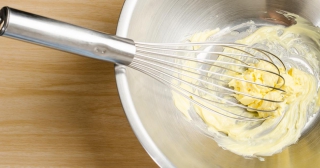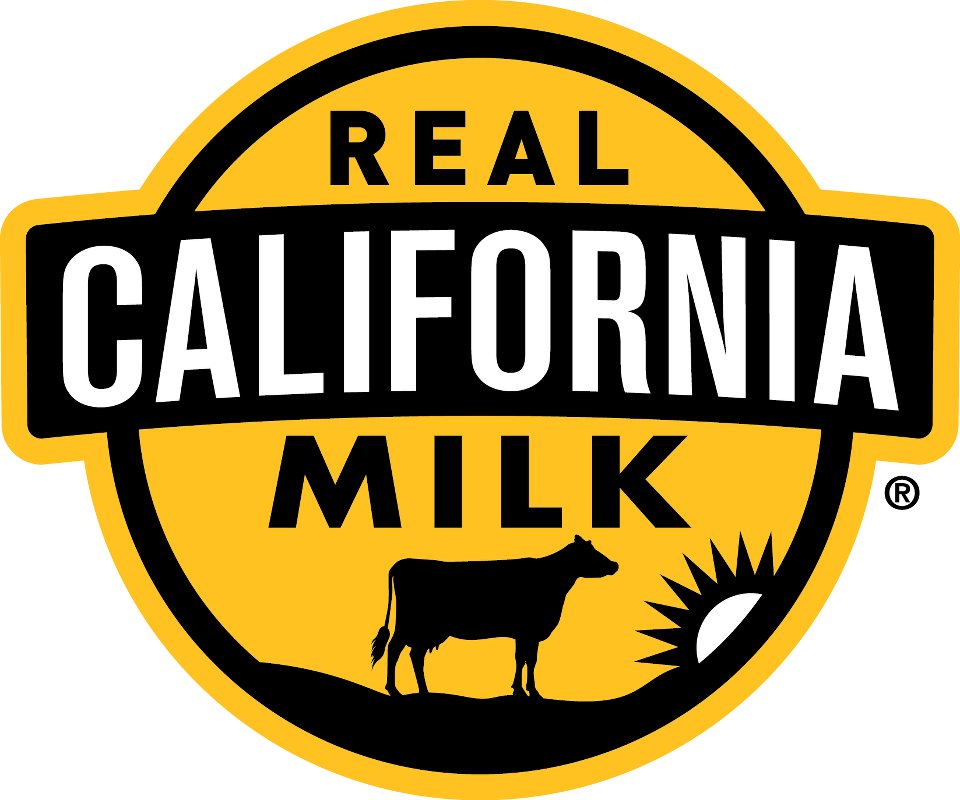
The Role of Butters and Creams in Baking
30 September 2016Teach students how butter, buttermilk, cottage cheese, cream, sour cream and yogurt are essential to bakery products’ tastes and textures.

Courtesy of the California Milk Marketing Board
The Role of Butter in Baking
Butter is paramount to bakers and butter delivers sumptuous flavor better than any other fat. Butter enriches baked goods by contributing tenderness and moistness, and is responsible for the flakiness in biscuits, pie crusts, and puff pastry. Because of its superior flavor, most bakers select unsalted butter over all other fats for use in baking.
What is Butter?
Butter is made from the milkfat in cream and contains at least 80 percent milkfat, 18 percent water and 2 percent solids (mainly protein and salt).
Variations:
Sweet Cream Butter, produced from cream, is the most common type of butter in the U.S. Butter is available salted or unsalted. You have more control over the flavor of baked goods when using unsalted butter since the amount of salt in salted butter varies among brands.
Light Butter contains 50 percent less fat than regular butter per serving and, while it’s delicious for topping breads or muffins, it should not be substituted for regular butter in baking recipes.
Cultured Butter is churned from cream that has been soured by a lactic acid-producing culture. It is more common in Europe than the U.S., but is available in California. Cultured butter has a stronger, riper flavor than sweet cream butter.
The Role of Buttermilk in Baking
Buttermilk is essential for adding tang and tender crumb characteristics to Southern favorites such as buttermilk biscuits, buttermilk pie, and cornbread. The acid in buttermilk, when combined with baking soda, produces light baked goods. In addition, buttermilk adds extra tenderness, moistness and flavor.
What is Buttermilk?
Buttermilk is a cultured milk with a tangy flavor and creamy texture. It is not a byproduct of butter production. Commercial buttermilk is soured and thickened with known bacterial cultures to maintain consistency, but is as versatile as buttermilk produced on the farm. Although buttermilk’s rich-sounding name and creamy texture suggest a high fat content, buttermilk is surprisingly low in fat and calories.
Variations
Buttermilk is available in nonfat and low-fat (1 percent to 2 percent) versions. Buttermilk comes in pint, quart and half-gallon cartons and is also available in dried form in 12-ounce cans (equivalent to 3.75 quarts).
Role of Cottage Cheese in Baking
Cottage cheese is another dairy product that adds flavor and the necessary fat for flakiness and tenderness to baked goods. Its unique curds can provide interesting texture to pastry dough, providing small bumps that brown beautifully in the oven.
What is Cottage Cheese?
Cottage cheese is a fresh, moist, mild cheese that features small, dense curds.
Variations
Commercial cottage cheese is available in nonfat, low-fat (1 percent milkfat), and whole (4 percent milkfat) varieties. It is usually made from nonfat milk to produce nonfat curds. However, manufacturers add some cream to nonfat curds to make “creamed cottage cheese,” which contains at least 4 percent milkfat.
The Role of Cream in Baking
Cream’s richness produces tender cakes and pastries with a luscious flavor. In dessert sauces and ice creams, cream acts not only as a liquid but also as a fat which adds richness and, not surprisingly, creaminess. Cream has a homogenizing effect on dessert sauces, unifying the flavors of all the component ingredients. Whipped cream, often a signature ingredient in desserts such as cream puffs, pumpkin pie, and strawberry shortcake, is indispensable for decorating and filling cakes and pastries. Folded into mousses, curds, and pastry cream, it lightens and creates a flawlessly smooth and creamy texture.
What is Cream?
Cream is the milkfat-enriched layer that rises to the surface of unhomogenized, whole milk after standing. To be called cream, a product must contain at least 18 percent milkfat. All cream produced in California is pasteurized.
The Role of Sour Cream in Baking
Sour cream is rich and acidic in nature. This semi-liquid acts as a fat to produce moist, tender textures in cakes and pastries. Acids tenderize baked goods by breaking down long, stringy protein molecules into smaller pieces. Gluten – a major ingredient in flour – is a protein, so acidic ingredients like sour cream are ideal for tender results.
What is Sour Cream?
Sour cream is cultured or acidified light cream. Cultured sour cream, which is the more common type, is soured and thickened by the lactic acid produced by a specific bacterial culture. Acidified sour cream is soured and thickened by the direct addition of an acid, such as vinegar.
The Role of Yogurt in Baking
Yogurt tenderizes the protein in flour, resulting in soft-to-the-bite muffins, pastries or cakes. Its slightly acidic flavor adds a bit of tang.
What is Yogurt?
Yogurt is a cultured milk product that is soured and thickened by the action of adding specific lactic acid-producing cultures (Lactobacillus bulgaricus and Streptococcus thermophilus) to pasteurized milk.
About the California Milk Marketing Board
The California Milk Advisory Board (CMAB), an instrumentality of the California Department of Food and Agriculture, is funded by the state’s more than 1,400 dairy families. With headquarters in Tracy, the CMAB is one of the largest agricultural marketing boards in the United States. For more information and to connect with the CMAB through social media, visit RealCaliforniaMilk.com.
